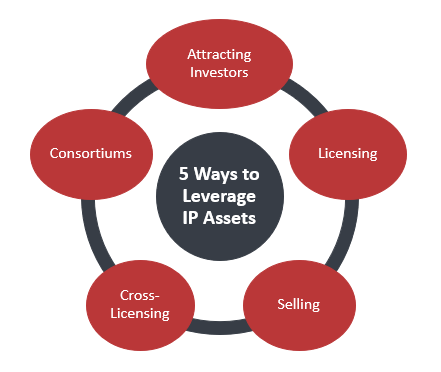Maximizing Profits: 5 Ways Small Businesses Benefit from Effective IP Management
In today’s fiercely competitive business landscape, small and medium-sized enterprises (SMEs) often confront formidable challenges, ranging from resource constraints to intense competition. Yet, amidst these hurdles lies a treasure trove often overlooked: IP management. While larger corporations have long recognized the strategic significance of IP, SMEs can leverage their intellectual assets to drive profitability and sustainable growth through effective IP management.
This article explores five strategic approaches tailored to help SMEs maximize the value of their IP portfolios, paving the way for enhanced competitiveness and profitability.
Table of Contents
Understanding the Role of IP Management in Small Businesses
Small businesses operate across diverse industries, each with its unique challenges and opportunities. Recognizing the role of IP is pivotal for SMEs striving to carve out a competitive niche. Beyond mere legal protection, IP management serves as a strategic tool for innovation, differentiation, and value creation. By safeguarding proprietary knowledge and technologies, SMEs can erect barriers to entry, deter competitors, and bolster their market positioning. Furthermore, effective IP management enables SMEs to utilize their IP assets as valuable collateral for securing financing, attracting investors, and fueling business expansion.
Strategic IP Filing for Enhanced Visibility
While IP protection is essential, SMEs often overlook the potential of IP to make them visible to potential customers and investors. The long periods of secrecy associated with IP filings, such as the 18-month publication delay for patent applications, can hinder SMEs’ visibility in the market. However, by strategically selecting specific IP authorities, such as those in Sweden or the UK; SMEs can expedite the publication of key elements of their IP filings, including title, assignee, and priority date. This approach allows SMEs to preserve confidentiality while making their IP filings visible to potential collaborators, investors, or licensees, thereby enhancing market visibility and attracting strategic partnerships.
Key Factors in Decision-Making for IP Management
Effective IP management requires careful consideration of several critical factors:
- Geography of Interest: SMEs should assess both current and future geographic markets of interest when determining their IP strategy. Understanding where their products or services are likely to be used or sold can help SMEs prioritize jurisdictions for IP protection.
- Enforcement of IP: SMEs must assess the enforceability of their IP rights in different jurisdictions. Knowing when and where IP can be effectively enforced helps SMEs safeguard their proprietary assets and deter infringement through strategic IP asset management.
- Cost Justification: IP is a significant investment for SMEs, requiring careful consideration of costs and expected results. SMEs must weigh the expenses associated with IP management against the potential benefits, ensuring that their IP strategy aligns with their overall business objectives.
By integrating these key factors into their IP decision-making process, SMEs can make informed choices that maximize the value of their intellectual assets while minimizing risks and costs.
Five Strategic Approaches for Leveraging IP Management for Profit

There are several ways to capitalize on IP assets for small businesses that have been using their limited resources to develop innovative technologies. Apart from getting a return on investment (ROI), such small businesses can also generate a healthy revenue stream using these five methods:
Attracting Investors for Manufacturing and Growth
Small businesses can translate IP assets into marketable products, attracting external investors for manufacturing expansion. Various funding sources, including starting from friends-family-fools, angel investors and venture capitalists, offer capital infusion, enabling SMEs to scale production and penetrate new markets.
Licensing: Monetizing IP Without Capital Outlay
Licensing offers SMEs a profitable pathway to monetize their intellectual property without requiring substantial upfront investment. By authorizing third parties to utilize, manufacture, or commercialize their patented technologies, SMEs can secure recurring income while retaining ownership of their IP. Collaborating with larger corporations broadens SMEs’ market reach and ensures a steady flow of royalties, thus fortifying revenue streams and ensuring sustained profitability. Furthermore, licensing arrangements facilitate market expansion, product diversification, and international growth, thereby reinforcing SMEs’ competitive edge in the market.
Selling: Unlocking Immediate Returns on IP Assets
For SMEs seeking immediate liquidity or divesting non-core assets, selling IP management assets can offer a viable exit strategy. Through comprehensive valuation and strategic marketing, SMEs can identify potential buyers and negotiate favorable terms for the sale of their IP portfolios. Whether to unlock capital for further innovation, streamline operations, or mitigate maintenance costs, selling IP management assets enables SMEs to realize immediate returns and optimize their resource allocation.
Cross-Licensing: Fostering Collaboration and Innovation
In today’s interconnected business landscape, cross-licensing agreements have emerged as a strategic tool for fostering collaboration and innovation. By exchanging access to their respective IP portfolios, SMEs can leverage complementary technologies, expand their product offerings, and accelerate the pace of innovation. Moreover, cross-licensing agreements enable SMEs to enhance market differentiation, mitigate the risk of IP litigation, and create synergies with industry partners, ultimately driving long-term value creation and competitiveness.
Collaboration: Pooling Resources for Mutual Growth
Collaborative partnerships offer SMEs a unique opportunity to pool resources, expertise, and market access for mutual growth and success. By partnering with complementary businesses within their industry or value chain, SMEs can leverage their collective strengths to drive innovation, scale operations, and capture new market opportunities. Whether through joint ventures, strategic alliances, or consortiums, collaborative partnerships enable SMEs to overcome resource constraints, mitigate risk, and capitalize on emerging market trends, thereby fostering sustainable growth and profitability.
Conclusion: Maximizing Profitability Through Strategic IP Management
In conclusion, small businesses stand to gain significant competitive advantages by strategically managing their IP management assets. By adopting a proactive approach to IP management and leveraging innovative strategies such as licensing, collaboration, and cross-licensing, SMEs can unlock new revenue streams, attract investment, and sustain long-term growth in today’s dynamic business environment. Moreover, by partnering with experienced IP service providers like Sagacious IP, SMEs can access specialized expertise and support to navigate the complexities of IP management, ensuring optimal outcomes and maximizing profitability in the digital age.
Our Patent Monetization and Licensing service offers comprehensive solutions, including portfolio ranking and identifying potential licenses. Learn more about our End-to-end Patent Licensing Support service that will enable you to turn your IP into a revenue-generating asset.
– By Abhinav Mahajan (ICT Licensing), Faiz Wahid (Global Stategic Initiatives & Europe Sales) and the Editorial Team




